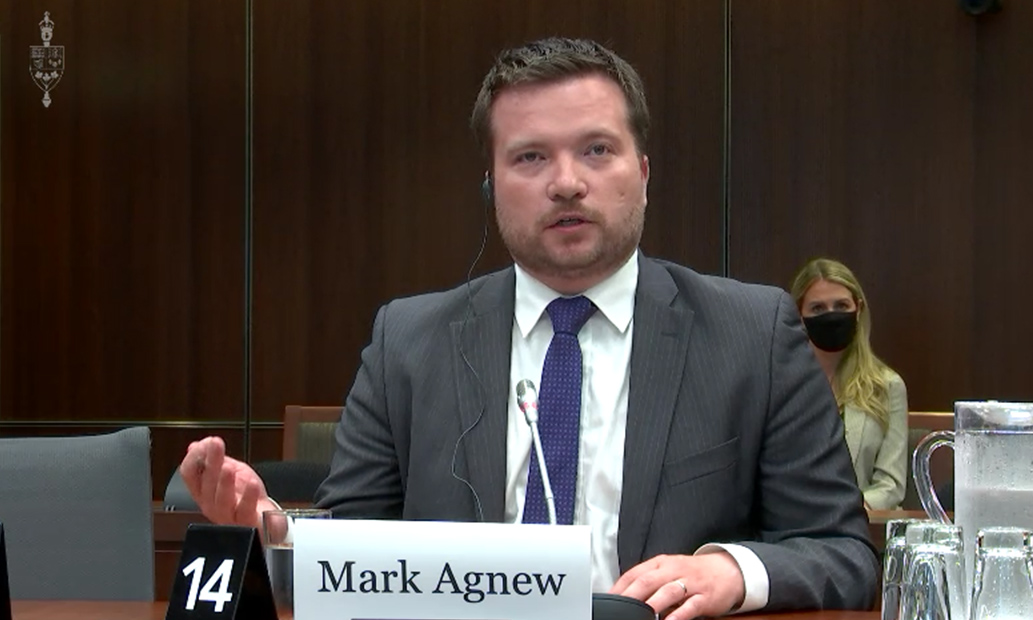Blog /
ArriveCAN App should be used to streamline, not complicate, border crossing: Canadian Chamber tells House International Trade Committee
ArriveCAN App should be used to streamline, not complicate, border crossing: Canadian Chamber tells House International Trade Committee
On June 15, 2022, Mark Agnew, the Canadian Chamber of Commerce Senior Vice President, Policy and Government Relations, appeared before...

On June 15, 2022, Mark Agnew, the Canadian Chamber of Commerce Senior Vice President, Policy and Government Relations, appeared before at the House of Commons Standing Committee on International Trade to address concerns around the border, customs backlogs, and the ArriveCAN App in particular.
Agnew advised committee members that using digital tools, such as the ArriveCAN App, to streamline border crossing procedures is important to help improve flow at Canada’s borders and enable contactless travel. Unfortunately, ArriveCAN’s experience has proven difficult as a result of it creating duplications, myriad locations to enter the same data, a lack of functionality, and problems with accessibility.
Fixing these problems is an urgent matter, with summer travel season arriving.
Mark Agnew’s opening statement
Check against delivery
Chair and honourable members, thank you for having me back again to this committee. It is a pleasure to be here in person. The Chamber is glad to see the committee take on this study as the summer travel season begins to ramp-up.
To say the pandemic has been a disruption to international travel is an understatement. We went through a complete decimation of travel flows and then backlogs at key points of entry as travel begins to ramp up. Executing effective border policies is not optional given the criticality of travel for the economy, whether it is tourism or business travel. We must get it right in order to ensure Canada remains an attractive destination for travellers. Given the long lead-in time for event planning, organizers will take decisions today that impact potentially 12-18 months out.
I want to turn to the committee’s main topic of interest, the ArriveCan app. The Canadian Chamber has long been a proponent of digitizing border procedures to support contactless travel. Unfortunately, the ArriveCan experience has proven difficult at the border.
The first point to note are the duplications created by the app. The traveller experience has been complicated by the diffuse places that the same information has to be inputted. As someone who recently travelled out of the country, it is striking that information is being entered through both my airline and the app profile.
The second point are the data requirements for the app, particularly for tourists from the US engaging in day trips. Travellers that would engage in day trip activities simply wouldn’t have a Canadian address. This directly impacts border communities and we’ve heard from those border town chambers about the impact on cross-border movement.
Third are the concerns with universal access. I am fortunate to have the tech literacy to use the app, but many travellers – particularly elderly travellers – do not always have that literacy. I was astounded to read from the CBC recently that a shop in Maine is offering dedicated services to help Canadians fill out the app. There are also issues for travellers whose first language is neither English nor French.
CBSA reported that as of the first week of April that 99% of air travellers and 94% of land travellers are using the app. With contact time with CBSA officers having significantly increased from the pre-pandemic 30 seconds per traveller, the system in its current form is not efficient and simply not working.
This isn’t to say scrap the app. As I noted a moment ago, digitizing border processes is vital. We instead should reorient the app to focus on streamlining customs procedures, as well as see what sort of manual alternatives may be needed in reserve.
Ultimately the app is in large measure a reflection of border policy.
The announcement last week of suspending randomized testing and moving testing out of airports was a welcome development, and this week partially lifting vaccine mandates is welcome news. However, there is more work ahead. For example, the decision to lift the outbound vaccination requirement, but maintain it for inbound travel, risks straining the system as this means tests of return and quarantine for unvaccinated Canadians coming back into the country.
With summer travel season here, and the last two seasons being missed, we don’t have the luxury of time to get this right.
Thank you for your attention and I look forward to your questions.
Related News

Time to put reports into action, Chamber tells House Agriculture Committee

2022 Q3 Canadian Survey on Business Conditions: Inflation is the top issue. Labour pains intensifying, but price pressures and supply chains issues are improving




